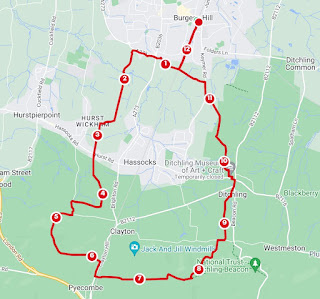Walking from Dorking
DORKING TO EWHURST VIA HOLMWOOD COMMON, LEITH HILL, HOLMBURY HILL AND PITCH HILL
A windy and drizzly start was disconcerting. I wanted to get a visit in at Leith Tower, which promised views up and down, towards the city of London and the South Downs. The temptation of a route on the greensand ridge was too good and the prospect of Dorking from Burgess Hill in an neat hour by train required little thought. Possibly a bit more thought should have been given on the return journey. This would have saved some pain because most exits back, appear to require you to ride above the North Downs to return to the southbound railway. I will have to investigate this more.
For all the contrast in geology, the exposed greensands exhibit a similar 'scarp and dip' topography as the chalk Downs but the high points appear leafier and equally beloved by the mountain bikers. The geographers have a lot to talk about too.
Dorking appears to be a bit interesting and the walk begins with only a brief taste of the attractions of the place. Leaving Dorking Deepdene, one of Dorking's greedily required stations, you meet the A24 and cross it to enter London Road. Tutts Close then takes you to follow the Pipp Brook all the way to Mill Lane where you cross it and go south. The A25, at the junction, is the High Street. Turn right and take the footpath past Sainsburys and the car park, cross Marlborough Road and join Chequers Place to meet the footpath to Rose Hill. I paused under a conifer to let the worst of a heavy rainshower pass. Back on South Street, turn left and you'll be on the Greensand Way, your guide for much of the walk. Follow the signs for The Nower and duck behind the hedge on Hampstead Lane to make your way up the hill. As I started my way out of town, the breeze had wafted much of the cloud onwards and I was delighted the sun could begin to dry my trousers and light the way.
Somehow, I missed the trig point near the Temple, a shelter on the hill with seating. Views are to be had just before you reach here to the north. There appear to be a few paths here buth the Way then descends to skirt Old Bury Hill and you don't appear to get any views of what remains of the house.
Now leave the long distance path and be sure to take the bridleway south. Ignore the signs that tell you the way beyond is private. These are not for you but a reminder that the lakes are part of the fishery. Carry on with confidence, with only fleeting glimpses of water to Chadhust Farm. As you leave the lakes behind, you'll see the buildings beyond. Turn left in the yard and join the farm road to Coldharbour Lane. Go north a little way and take the footpath on the right. Bear left when the path splits and follow the hedge to Holmwood Farm. Cross the Horsham Road on the footpath. It's not too difficult. Cross Spook Hill and cut the corner of the field to join the path by the church.
This is Holmwood Common. Have a wander in this National Trust wooded area. I roughly followed a route south to the viewpoint at the centre of a spider of paths on the higher ground and then went west to cross back to the bridleway to Folly Farm. The path rises steadily into the woods beyond. On reaching the edge, go northwest and then continue roughly in this direction and switch back south on a bridleway. You'll realise that I've simply taken this route bag another trig, deep in the trees. Go east into Abinger Forest. I picked my way through the pines, crossed the byway, went south a little and took the deeply rutted bridleway on the National Trust Coldharbour Common and The Duke's Warren. The heather was beginning to show its colours. Whiteberry Road going south is the Greensand Way again and you will reach the edge after a steady climb. The signs to the tower and Leith Hill will appear on your right. There is a cafe at the base of the tower and the tower itself is open some weekends and Fridays. I had a welcome stop here.
Continue with easy navigation through more wood, over Leith Hill Road and on to Pasture Wood Road. Go north on the Horsham Road and take Pitland Street. I also stopped for a substantial lunch at the King's Head, on the right. Back on the road, follow the footpath sign on the right and take the way west towards Holmbury Hill. The way takes you by the iron-age hillfort before reaching the trig. The Hurt Wood is home to Hurt berries. Various named as whortleberries or huckleberries, they are local to this part of Surrey.
I followed the path out of the wood, crossing Radnor Road and through the cow fields to the Duke of Kent School. The way goes behind the building and up to our final hill. From Pitch Hill and the trig, take the footpath directly steeply down south. A further viewpoint is found a little lower. Continue to Moon Hall Road and turn right. From the Ride Way, switch back down Shere Road. Follow Coneyhurst Gill and the woods until you reach the edge of Sayers Croft Nature Reserve. Take Wykehurst Lane east to Ewhurst and The Bull's Head. Here I took the bus into Cranleigh and on to Shalford Station and home. I was rushed and hassled as all of my potential exits took so much time. It was still early afternoon and this hasty exit was disappointing. Looks like a revisit might make a more satisfactory end.


Comments
Post a Comment